Sweet Corn
Fall armyworm (FAW) infestations in whorl stage plantings remain a presence, although in many scouted fields in northern and central counties, the incidence of FAW has declined. Treated fields are not typically experiencing re-infestation. This may not be the case in southern counties. Growers are advised to check whorl and seedling stage corn plantings weekly for signs of FAW. Consider treating if infestation rates exceed 10%. This pest is capable of significant injury to sweet corn plants, resulting in severe stunting and failure to produce viable ears. Note that growers of Attribute II type genetically engineered corn are unlikely to see damage from FAW.
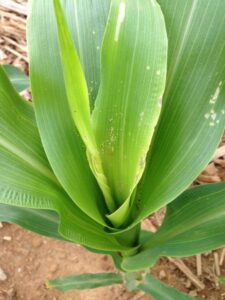
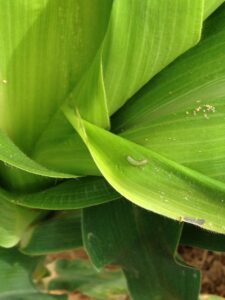 Newly hatched FAW larvae cause holes and scratches on leaves that are similar to European corn borer (ECB) feeding, except that they tend to be more concentrated and always lead down into the whorl (see photos at left). As the larvae grow, the feeding becomes more destructive, with large ragged holes and obvious droppings deposited in the whorl (see photo at right).
Newly hatched FAW larvae cause holes and scratches on leaves that are similar to European corn borer (ECB) feeding, except that they tend to be more concentrated and always lead down into the whorl (see photos at left). As the larvae grow, the feeding becomes more destructive, with large ragged holes and obvious droppings deposited in the whorl (see photo at right). 
We will provide updates on new FAW appearances and severity as reports come in. FAW are resistant to synthetic pyrethroids. Effective sprays should include IRAC grp. 5 (spinosyns) or IRAC grp. 28 (diamides). The carbamate (IRAC grp. 1A) Lannate is also still effective. Sufficient water should be used in the applications to allow the solution to penetrate the layer of droppings that may have formed above the caterpillar.
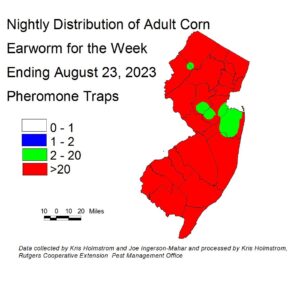
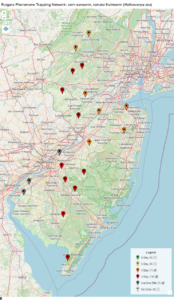 Corn earworm (CEW) moths captures from northern and central blacklight traps have increased again over the past week, as the maps show. Pheromone trap information is available from all northern and central sites, with input from southern New Jersey. We will use a combination of pheromone and blacklight trap types to derive silk spray schedules by region. A corresponding increase in CEW numbers from reporting pheromone traps has also occurred. Very high catches are occurring northward into Hunterdon County at this time. Cool evening temperatures late this week may suppress activity temporarily. Silking corn is at extreme risk of CEW infestation at this time. Red areas on the map at right correspond to a 3-day spray schedule. Be sure to access information from this publication in the upcoming weeks to determine how frequently you should treat silking sweet corn to protect it from CEW infestation.
Corn earworm (CEW) moths captures from northern and central blacklight traps have increased again over the past week, as the maps show. Pheromone trap information is available from all northern and central sites, with input from southern New Jersey. We will use a combination of pheromone and blacklight trap types to derive silk spray schedules by region. A corresponding increase in CEW numbers from reporting pheromone traps has also occurred. Very high catches are occurring northward into Hunterdon County at this time. Cool evening temperatures late this week may suppress activity temporarily. Silking corn is at extreme risk of CEW infestation at this time. Red areas on the map at right correspond to a 3-day spray schedule. Be sure to access information from this publication in the upcoming weeks to determine how frequently you should treat silking sweet corn to protect it from CEW infestation.
The highest nightly blacklight trap catches of CEW (north and central counties) for the week ending 8/23/23 are as follows:
| Bellemeade 16 | Denville 8 | Milltown 4 |
| Hillsborough 14 | Allentown 6 | South Branch 4 |
| Princeton 13 | Hackettstown 6 | Morristown 4 |
| Georgetown 12 | Matawan 4 | Sergeantsville 4 |
The highest nightly pheromone trap catches of CEW for the week ending 8/23/23 are as follows:
| Tabernacle 211 | Califon 82 | Berlin 45 |
| Snyder Farm (Hunterdon) 138 | Chester 77 | South Branch 22 |
| Elm 90 | Green Creek 46 | Georgetown 20 |
| Springdale 83 | Pennington 46 | Dayton 19 |
Silking Spray Schedules*:
South – 3 days
Central – 3 days
North – 3 days
*These recommendations are based on regional catches. Adhere to tighter spray schedules if indicated by local trap catches. Synthetic pyrethroids alone should NOT be used for corn earworm (CEW) protection on silking corn, or for fall armyworm (FAW) management at any stage. Control with these materials is very inconsistent.
Sap Beetles
Growers experiencing problems with sap beetles during harvest should consider adding the active ingredient acetamiprid in 1-2 silk applications along with the CEW targeted materials. This IRAC group 4A material (Assail, Anarchy) will not control CEW, but is useful for sap beetles and corn leaf aphids. Hot days and warm nights favor sap beetle infestations, particularly when corn ears grow to the end of the husks, enabling easy entry for the beetles.
Cucurbit Downy Mildew
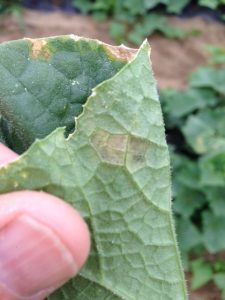
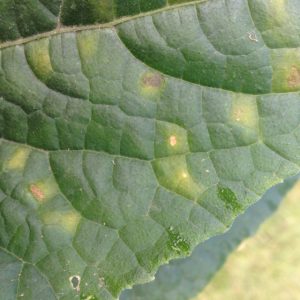 Cucurbit downy mildew is impacting cucumbers in all parts of New Jersey at this time, and limited cantaloupe infections in southern NJ have been reported. All cucumber and cantaloupe plantings should be protected. Useful materials for CDM may be found in the Cucumber Section of the 2022/23 Commercial Vegetable Production Recommendations. A sentinel plot is established at Snyder Farm in Hunterdon County, consisting of pumpkin, watermelon, cantaloupe, butternut, acorn, cucumber and kabocha squash will be used to indicate the presence of cucurbit downy mildew in the region, and what crops are affected. As of 7/21/23, CDM was detected on cucumbers in this plot in Hunterdon County. As of 8/22/23, no other crops were infected in this plot, nor has CDM been detected in any northern or central county pumpkin or winter squash field. For regional information on this important disease, see the Cucurbit Downy Mildew webpage: http://cdm.ipmpipe.org/. Within the past week, CDM was reported on butternut squash in Lancaster County, PA. Note that the forecast component of this site is not active this season. However, occurrences of CDM can still be reported on the site, and may appear on the homepage map down to county level with associated host information. It is critical that growers subscribe to the Vegetable Crops edition of the Plant and Pest Advisory in order to receive the most current information on outbreaks from Dr. Andy Wyenandt. Heavy rains favor arrival and spread of this disease. All growers should be checking potential host crops at least once a week for signs of infection. Symptoms on the upper leaf surface are yellow lesions bordered by leaf veins (upper right photo), while on the lower surface, dark sporulation may be found (upper left photo).
Cucurbit downy mildew is impacting cucumbers in all parts of New Jersey at this time, and limited cantaloupe infections in southern NJ have been reported. All cucumber and cantaloupe plantings should be protected. Useful materials for CDM may be found in the Cucumber Section of the 2022/23 Commercial Vegetable Production Recommendations. A sentinel plot is established at Snyder Farm in Hunterdon County, consisting of pumpkin, watermelon, cantaloupe, butternut, acorn, cucumber and kabocha squash will be used to indicate the presence of cucurbit downy mildew in the region, and what crops are affected. As of 7/21/23, CDM was detected on cucumbers in this plot in Hunterdon County. As of 8/22/23, no other crops were infected in this plot, nor has CDM been detected in any northern or central county pumpkin or winter squash field. For regional information on this important disease, see the Cucurbit Downy Mildew webpage: http://cdm.ipmpipe.org/. Within the past week, CDM was reported on butternut squash in Lancaster County, PA. Note that the forecast component of this site is not active this season. However, occurrences of CDM can still be reported on the site, and may appear on the homepage map down to county level with associated host information. It is critical that growers subscribe to the Vegetable Crops edition of the Plant and Pest Advisory in order to receive the most current information on outbreaks from Dr. Andy Wyenandt. Heavy rains favor arrival and spread of this disease. All growers should be checking potential host crops at least once a week for signs of infection. Symptoms on the upper leaf surface are yellow lesions bordered by leaf veins (upper right photo), while on the lower surface, dark sporulation may be found (upper left photo).
Pumpkins and Winter Squash
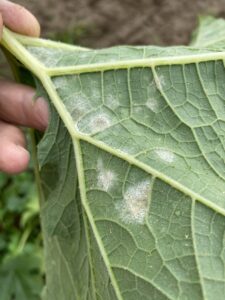 Powdery mildew (PM) thresholds (2 infected leaves/50 leaf sample) have been reached in all scouted plantings. Once PM lesions (photo at right) begin to appear, the fungicide program for this disease should be initiated. The program generally includes a combination of broad spectrum protectants and more targeted, locally systemic fungicides. Try to select 2-3 systemics with different FRAC codes for a solid rotation to avoid development of resistance to the fungicides. For a complete list of suggested materials, see the Pumpkin and Winter Squash Section of the 2022/23 Commercial Vegetable Production Recommendations.
Powdery mildew (PM) thresholds (2 infected leaves/50 leaf sample) have been reached in all scouted plantings. Once PM lesions (photo at right) begin to appear, the fungicide program for this disease should be initiated. The program generally includes a combination of broad spectrum protectants and more targeted, locally systemic fungicides. Try to select 2-3 systemics with different FRAC codes for a solid rotation to avoid development of resistance to the fungicides. For a complete list of suggested materials, see the Pumpkin and Winter Squash Section of the 2022/23 Commercial Vegetable Production Recommendations.
Cole Crops
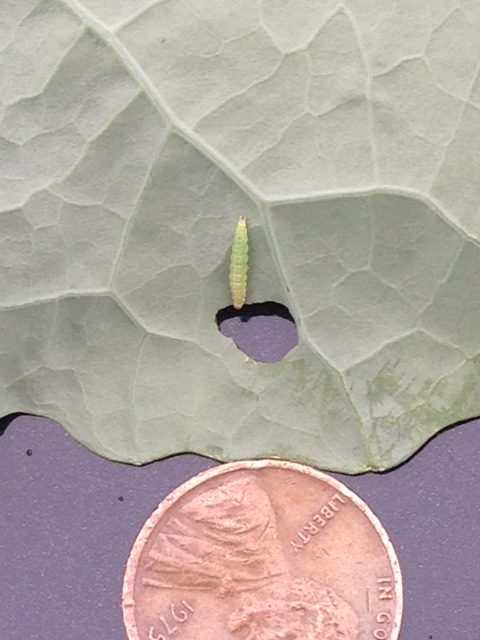 With fall plantings now establishing, it is typical for diamondback moth larvae ((DBM) see photo at right) to become the dominant caterpillar pest in many cole crop fields. This pest can multiply quickly, with a generation completed in under 2 weeks with high temperatures. Furthermore, this pest is not responding to chlorantraniliprole (Coragen) in many parts of the state. Effective materials continue to be IRAC 5 materials (spinosyns), other IRAC 28 products like Exirel, the IRAC 6 material, ememectin benzoate (Proclaim). Reports of good efficacy with the IRAC 21A tolfenpyrad (Torac) are coming in from consultants and IPM scouts. Be sure to check the Cole Crops Section of the 2022-23 Commercial Guide for specifics, as PHI’s and crop labels vary. It is important to return to treated fields within 2-3 days to assess the efficacy of the insecticide applications. Effective materials should eliminate DBM larvae within 48 hours.
With fall plantings now establishing, it is typical for diamondback moth larvae ((DBM) see photo at right) to become the dominant caterpillar pest in many cole crop fields. This pest can multiply quickly, with a generation completed in under 2 weeks with high temperatures. Furthermore, this pest is not responding to chlorantraniliprole (Coragen) in many parts of the state. Effective materials continue to be IRAC 5 materials (spinosyns), other IRAC 28 products like Exirel, the IRAC 6 material, ememectin benzoate (Proclaim). Reports of good efficacy with the IRAC 21A tolfenpyrad (Torac) are coming in from consultants and IPM scouts. Be sure to check the Cole Crops Section of the 2022-23 Commercial Guide for specifics, as PHI’s and crop labels vary. It is important to return to treated fields within 2-3 days to assess the efficacy of the insecticide applications. Effective materials should eliminate DBM larvae within 48 hours.

